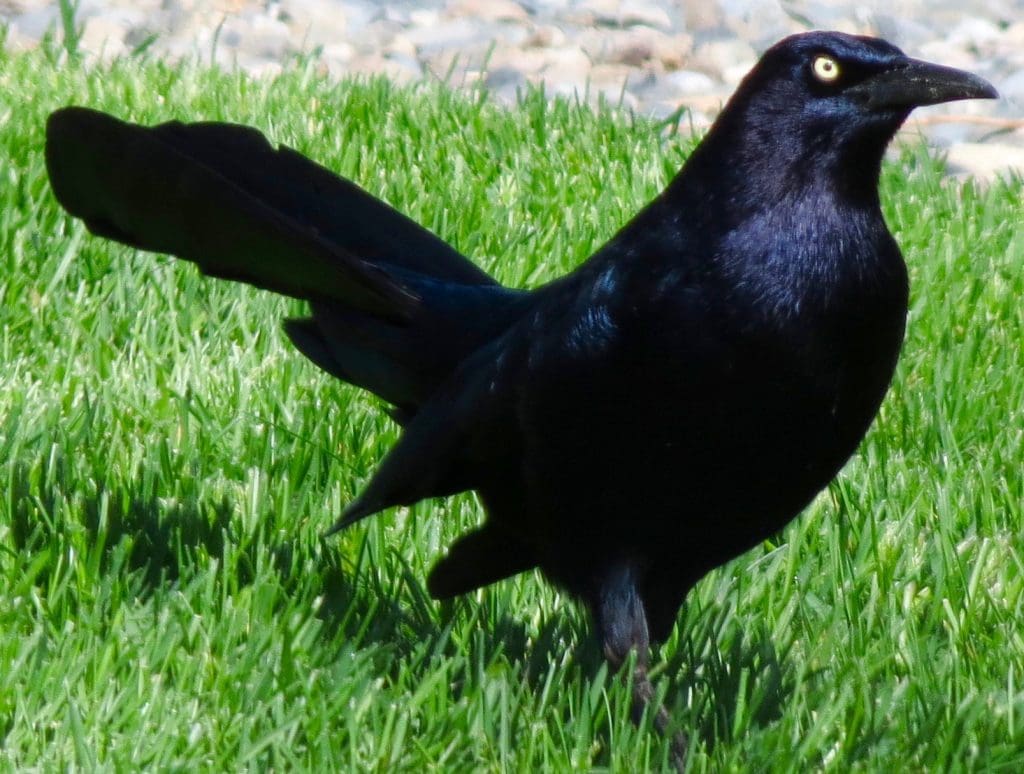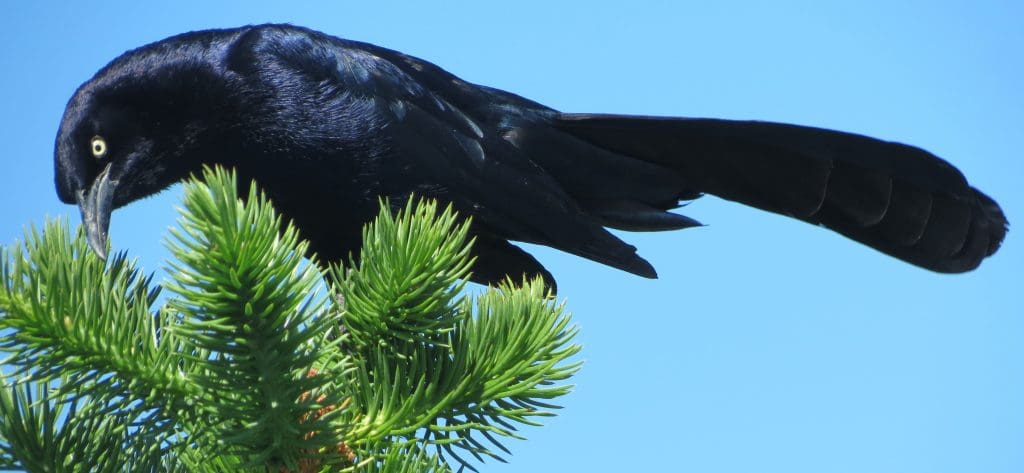November 28, 2016
University of Montana Western Professor of Biology Jack Kirkley may have stumbled upon the first nesting colony of a rare species of grackle in the small college town of Dillon, Mont.

University of Montana Western Professor of Biology Jack Kirkley may have stumbled upon the first nesting colony of a rare species of grackle in the small college town of Dillon, Mont.
Grackles are medium-sized, all-black birds found throughout Central, South and North America.
Officially, there are three species of grackles in North America: the Great-tailed Grackle, Common Grackle and Boat-tailed Grackle. Traditionally, only the Common Grackle was typically found in Montana. However, the significant range expansion of the previously subtropical Great-tailed Grackles into the western half of the United States during the past 100 years has resulted in their major overlap with the range of the Common Grackle. Those two grackle species were never known to interbreed…until now.
Kirkley, an ornithologist (bird biologist) by training, noticed some very odd behaviors in one local male Great-tailed Grackle that he discovered for the first time in March 2013. In 2014, that male grackle nested just a couple of blocks west of Montana Western’s campus, becoming the first documented nesting attempt for this species of grackle in the state of Montana.

But in 2015, Kirkley suspected this male, defending a nest in the exact same location in the nest tree, had instead fathered offspring with a female Common Grackle, because Kirkley saw both of these parents feeding a pair of recently fledged young in the treetop near their nest. DNA analysis of a feather from one of those fledglings confirmed that it was the hybrid offspring of those two different species of parents, a first ever record of hybridization between these two species of grackles.
Additionally that year, the male became the primary or sole caregiver to that pair of hybrid offspring, a parental behavior which, according to the literature, is highly unusual for male Great-tailed Grackles. “Males of this species almost never help the females raise their young.” Kirkley explained. “By late July, however, this male was the only adult feeding those two, nearly full-grown, fledglings.”
In order to test the possibility that this male might also have some hybrid genes, Kirkley spent a few months diligently staking out the movements of the male Great-tailed Grackle near the local McDonald’s parking lot, while also collecting the male’s molted feathers for future DNA analysis. The bird’s feathers could potentially hold the necessary DNA evidence to shed light on his genetic identity.
Kirkley and his research collaborators are still trying to determine if the male is a pure Great-tailed Grackle or some kind of hybrid.
“The McDonalds Great-tailed Grackle, that I’ve nicknamed “McGrackle,” was behaving in ways I have never seen before and he’s been breaking a lot of the rules for his species,” Kirkley said. “I am excited to have his DNA examined more thoroughly to figure out exactly what he is, a pure Great-tailed Grackle or some hybrid mix.”
In addition to collaborating with a grackle genetics expert in Kansas, Kirkley also turned to his Montana Western colleague and fellow Biology Professor Mike Morrow to assist with the DNA analysis of the grackle. Morrow’s Advanced Molecular Biology class took on the task of helping Kirkley with his grackle identity puzzle.
“It was a great, collaborative opportunity for my students to obtain some hands-on experience attempting to solve the grackle mystery,” Morrow said. “Montana Western students have an advantage with the block system in that they can focus on one class at a time, which lends itself to tackling special projects like the grackle case.”
Morrow’s class took three of the molted McGrackle feathers that Kirkley had collected and attempted to extract a key segment of DNA from them.
“Nuclear DNA found in an animal’s chromosomes comes equally from its mother and its father,” Morrow explained. “By looking at those chromosomes we can determine the species identity of both parents of an offspring. That is what we attempted to do with the McGrackle samples.”

They then used a technique called polymerase chain reaction (or PCR) to amplify two genes from McGrackle’s chromosomes. This technique produces billions of copies of the gene of interest, which can be analyzed for the DNA’s code sequence.
“By amplifying the genes from McGrackle’s chromosomal DNA and then sequencing them, we should be able to determine if McGrackle has any DNA from a Common Grackle,” Morrow said. “If it only has Great-tailed Grackle chromosomal DNA, then both of McGrackle’s parents were Great-tailed Grackles. If any Common Grackle sequences are found, then one of McGrackle’s parents must have been a Common Grackle.”
“The jury is still out on this particular mystery, as the DNA sample from shed feathers was not as rich as that which may be obtained from a half-grown feather that still contains blood or an actual blood sample,” Kirkley explained.
In pursuit of those DNA-rich tissues, Kirkley will continue his early morning stake-outs in the vicinity of McDonalds, attempting to capture and band the mysterious McGrackle in hopes of obtaining a better tissue sample for further DNA analysis.
“Stay tuned, as the McGrackle story isn’t over yet,” Kirkley said. “The mystery grackle is still here in Dillon, and it looks as though he is going to spend his second consecutive winter in Montana, just as he managed to do last winter. How a subtropical bird manages to survive a Montana winter is sure a mystery to me. He’s one strange bird!”
— Montana Western —